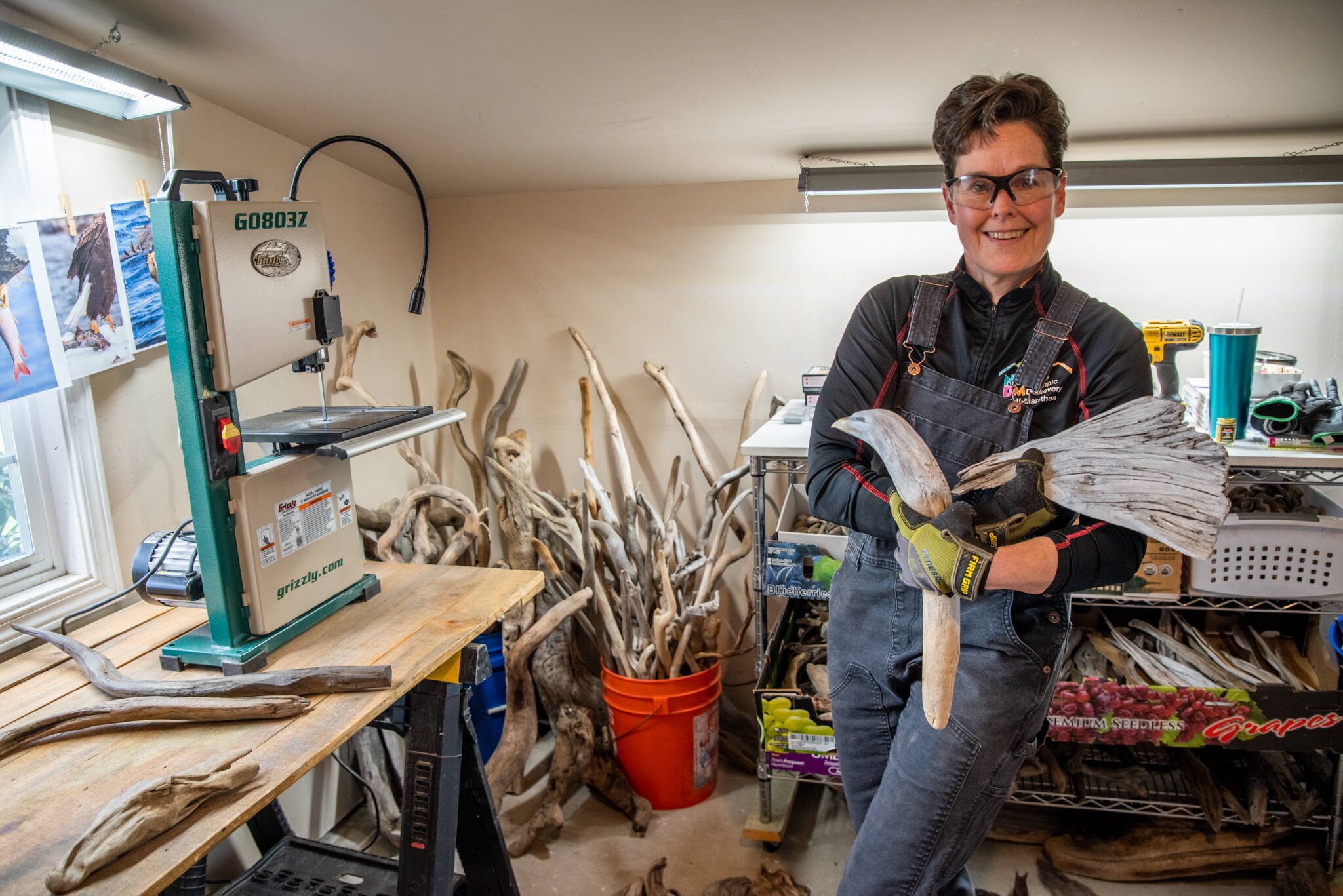Growing up, Molly Omann knew what she wanted.
“I was one of those kids that said, ‘I want to grow up to be an artist.’
“Thankfully, I had an awesome art teacher at my tiny high school, who really encouraged me to pursue that dream.”
Omann attended the Colorado Institute of Art, graduating with a degree in Advertising Design, which launched her into a life of exploring art in a variety of mediums and settings, as well as volunteering time teaching others and cultivating a career that ranged from instruction to newspaper graphic design to marketing her own art, all while raising two sons and, with her husband, building or remodeling four of their own houses over the years.
“I sometimes say ‘so many mediums, so little time’,” says Omann.
Leaving an ad designer position with Sound Publishing in 2022, Omann is now a self-employed professional artist, dedicating much of her time to creating life-sized driftwood sculptures, primarily of animals. These pieces take an average of 200 hours, from start to finish.
She charges a fair price for her time, and word-of-mouth has brought most of the commissions that have kept her busy. She welcomes more.
Omann jokes that she gets paid to beachcomb, because it is there the process begins: She chooses beaches with heavy and constant concentrations of driftwood.
“I only use solid pieces without any punk,” she says.
“I haul lots of wood home and then dry and sort by size and shape. I print out and study all angles of my subject, hanging pics and measurements up in my workshop.
“As I collect and puzzle together the driftwood I look for the perfect shape of, for example, the ear of an elk. If I don’t have the perfect piece, then it’s back to the beach.”
As she builds her sculptures, she treats each piece with tung oil to prevent rot. When the sculpture is complete, she coats it with spar varathane varnish — three coats on sculptures for exterior display or one coat for interior sculptures.
Sun damage is the worst culprit, she says, so she recoats exterior works regularly.
“I really feel blessed,” Omann says, describing days where the hours flow past as she concentrates on work that brings her joy.
She rents a neat, organized small studio with a sloping ceiling. Power tools, piles of dried, sorted driftwood, chemicals and study materials all have their place in its 12-foot-by-12-foot interior.
Omann’s latest creation, “Fisher King,” is a 57-inch-tall eagle with a 30-inch wingspan, measuring 25 inches from beak to tail. The eagle is splashing into an epoxy riverbed of local rocks to nab a driftwood fish, built using hidden steel rods and set on a “toothbrush table” of alder poles with river rocks glued in.
The entire process took 312 hours; Omann calls it her most challenging piece.
“I wanted to sculpt an eagle, but everyone does eagles, so my idea was to have the bird snatching a fish from the river,” she says.
She enlisted the help of “my talented friend” and fellow craftsman Don Meyer to help with the process of creating the riverbed, which they had no prototype or model for.
Meyer “builds river tables from incredibly beautiful wood using epoxy resin to pour rivers of color down the center of two slabs,” Omann says.
“After a lot of research on the many different epoxy resins out there, I chose Ultra Clear for the deep pour epoxy and Naked Fusion art epoxy to create a splash effect.
“Since the eagle needed to be well supported, I built the legs first from the talons to the shoulders, drilled a rod of steel up through to go into the body. I built the fish and attached the talons around it, then embedded that in the epoxy as we poured.”
The pair built a form and a jig to suspend the eagle legs and fish in the river. Omann says she collected and washed all sizes of rocks, from pea gravel to Dungeness River rock and poured the epoxy in the form around it all.
“As resin heats up you can only do deep pours generally an inch at a time [so] every 24 hours we poured another layer…. The mirror effect when we demolded the whole thing was a spectacular surprise.”
Omann says that in deciding to pursue an independent art career, she and her husband “took a leap of faith,” but with “word of mouth, exposure and a lot of prayer,” it is working out and she hopes to continue until her last breath.
Two of her sculptures, “Lone Guardian” and “Mac the dog,” can be viewed after April 1 out at the beach off Place Road in Port Angeles.
For more about Omann’s work, see driftwoodsculptor.com or https://www.facebook.com/people/Olympus-Creations/100054359225564/ .
Email Omann for more info or commission inquiries at mollyomann@gmail.com.



